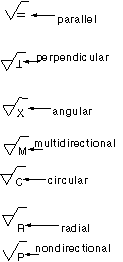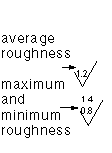Valid Surface Finish Symbol Groups
The following table describes the groups that you can use to create a surface finish symbol. The first column indicates whether it is an ANSI or ISO symbol, or both.
Creating a Surface Finish Symbol
|
ISO/ ANSI
|
GROUPS
|
DESCRIPTION
|
ILLUSTRATION
|
|---|---|---|---|
|
ANSI
ISO
|
LEADER
|
Used to create a symbol leader.
|
 |
|
ISO
ANSI
|
MACHINED
|
Material removal by machining is required.
|
 |
|
ISO
ANSI
|
NO_REMOVAL
|
Material removal prohibited.
|
 |
|
ISO only
|
PROD_METHOD
|
Text used for specifying production method.
|
 |
|
ANSI
only
|
ROUGH_SPACE
|
Required maximum roughness spacing (mm or inch).
|
 |
|
ISO
ANSI
|
SAMPLE_LEG
|
Roughness sampling length or cutoff rating (mm or inch).
|
 |
|
ISO
only
|
OTHER_ROUGH
|
Text used for specifying other roughness.
|
 |
|
ANSI
only
|
DESIGNATION
|
Text used for special designations.
|
 |
|
ISO
ANSI
|
REMOVAL
ALLOW
|
Material removal by machining that is required to produce the surface (mm or inch).
|
 |
|
ISO
ANSI
|
LAY
|
Designates direction of lay. The system supports the following types:
PARALLEL—Approximately parallel to the line representing the surface to which the symbol is applied.
PERP—Approximately perpendicular to the line representing the surface to which the symbol is applied.
ANGULAR—Angular in both directions to the line representing the surface to which the symbol is applied.
MULTI_DIR—Multidirectional.
CIRCULAR—Approximately circular relative to the center of the surface to which the symbol is applied.
RADIAL—Approximately radial to the center of the surface to which the symbol is applied.
NON_DIR—Nondirectional, or protuberant.
|
 |
|
ISO
ANSI
|
UNSPECIFIED
|
Basic surface texture symbol. You can produce the surface by any method, except when the bar or circle is specified.
|
 |
|
ANSI
only
|
WAVINESS
|
Specified waviness (mm or inch):
WAVE_HEIGHT—
Maximum waviness height.
WAVE_SPACE—Maximum waviness spacing.
|
 |
|
ISO
ANSI
|
ROUGHNESS
|
Roughness rating indicates permissible roughness range (mm or inch). The system supports these types:
AVERAGE—Roughness average rating.
MAX_MIN—Maximum and minimum roughness average values.
|
 |